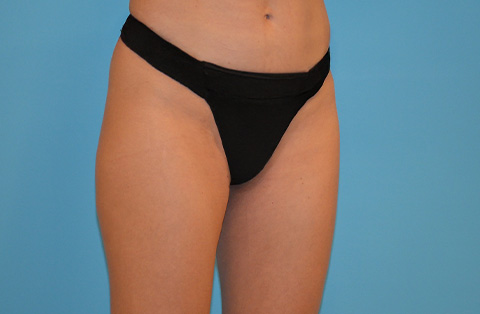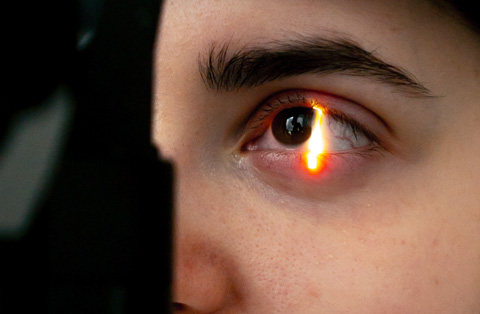Under-eye bags can make you look more tired and older than you actually are, but a groundbreaking solution is available.
Transconjunctival blepharoplasty, a sophisticated technique in eyelid surgery, addresses these concerns effectively. This procedure involves removing or repositioning fat from the lower eyelids without external incisions, leaving no visible scars. The technique is not only minimally invasive but also significantly reduces the risks of traditional approaches.
If you're seeking a fresher, rejuvenated appearance, transconjunctival blepharoplasty offers a promising option. Dive into the details of how this modern approach can safely and effectively revitalize your appearance.
What is Transconjunctival Blepharoplasty?
Transconjunctival blepharoplasty is a cosmetic eyelid surgery that targets the lower eyelids. Surgeons perform this procedure to remove or reposition excess fat, thereby reducing under-eye bags. They make incisions inside the eyelid, ensuring no visible scars remain.
This method minimizes swelling and bruising compared to traditional techniques, offering a quicker recovery and less disruption to the eyelid's natural structure. It is ideal for improving under-eye appearance without external scarring.
The Benefits of a Transconjunctival Approach Over Traditional Eyelid Surgery
The transconjunctival approach to eyelid surgery offers several advantages over traditional eyelid surgery methods:
No Visible Scars: Surgeons make incisions inside the lower eyelid, leaving no external scars.
Reduced Risk of Complications: This technique minimizes the potential for lower eyelid malposition, such as ectropion.
Less Swelling and Bruising: The internal incisions typically result in less postoperative swelling and bruising, speeding up recovery time.
Preservation of Eyelid Structure: It maintains the integrity of the eyelid by not disturbing the muscle or external skin.
Focused Fat Removal: Allows precise removal or repositioning of fat without unnecessary disturbance to surrounding tissues, making it ideal for patients with moderate under-eye bags.
Understanding the Procedure: How It's Performed
Understanding how transconjunctival blepharoplasty is performed helps patients know what to expect during the procedure. Here’s a step-by-step breakdown:
Anesthesia Administration: Doctors administer local anesthesia to numb the area, ensuring patient comfort.
Incision Making: The surgeon makes a small incision inside the lower eyelid.
Fat Removal or Repositioning: The surgeon accesses and either removes or repositions the fat beneath the eye.
Incision Closure: They then close the incision, typically without the need for sutures.
Recovery: The procedure often requires minimal downtime, allowing patients to return to normal activities relatively quickly.
This method offers a targeted approach to reducing under-eye bags with minimal disruption to the eyelid’s structure.
Why Consider Transconjunctival Approach for Lower Eyelid Bags?
Considering the transconjunctival approach for lower eyelid bags is beneficial for several reasons:
Minimally Invasive: It involves small incisions inside the eyelid, making it less invasive than traditional methods.
No External Scarring: Since the incision is inside the eyelid, it leaves no visible scars.
Reduced Recovery Time: Patients typically experience quicker recovery times with less swelling and bruising.
Lower Risk of Complications: The approach reduces the risk of eyelid malposition and other complications associated with external incisions.
Effective Fat Removal: It allows precise targeting of fat deposits, improving under-eye appearance significantly.
This approach is particularly suitable for individuals looking to address under-eye bags without the downsides of traditional surgery.
Eye Bag Removal Without Visible Scars
Eye bag removal without visible scars is possible with the transconjunctival lower blepharoplasty technique. Surgeons make incisions inside the lower eyelid, avoiding any external cuts. This method targets and removes or repositions the fat deposits effectively.
Patients benefit from not having any noticeable scars, enjoying a cleaner and more natural post-surgery appearance. This approach ensures that the recovery is not only quicker but also aesthetically pleasing.
Addressing Lower Eyelid Laxity and Herniated Fat
Surgeons perform transconjunctival blepharoplasty to access and correct these issues from inside the lower eyelid. This method targets the fat that bulges beneath the eye, effectively repositioning or removing it. It also tightens any laxity, enhancing the eyelid's firmness and appearance. This approach results in a smoother, rejuvenated under-eye area without external scars.
Improvements in Lower Eyelid Contour
This procedure directly addresses under-eye issues by removing or repositioning herniated fat. Surgeons work through small internal incisions, allowing them to refine the eyelid's shape without visible scars. This targeted adjustment leads to a smoother, more youthful eyelid contour. Patients enjoy a refreshed appearance, as the procedure corrects the bulges and tightens the skin effectively.
Comparing Transconjunctival Blepharoplasty to Traditional Eyelid Surgery
Transconjunctival blepharoplasty offers a distinct advantage over traditional eyelid surgery by focusing on minimal invasiveness and no visible scarring. While traditional methods involve external cuts that may leave scars, the transconjunctival technique makes incisions inside the eyelid. This approach reduces recovery time and the risk of complications like eyelid malposition.
Aspect | Transconjunctival Blepharoplasty | Traditional Eyelid Surgery |
Incision Location | Inside the eyelid | External on the eyelid |
Scarring | No visible scars | Possible visible scars |
Recovery Time | Shorter | Longer |
Risk of Complications | Lower | Higher |
Target Issue | Primarily fat deposits | Fat, skin, and muscle |
The Significant Differences in Incision and Scarring
The significant differences in incision and scarring between transconjunctival blepharoplasty and traditional eyelid surgery are notable. Transconjunctival blepharoplasty involves incisions made inside the lower eyelid, resulting in no visible scars.
In contrast, traditional surgery makes cuts on the external surface of the eyelid, often leaving visible scars. This internal approach not only preserves the natural appearance of the eyelid but also significantly reduces the visibility of any surgical marks.
Why Transconjunctival May Offer Better Results for Eye Bag Removal?
Transconjunctival blepharoplasty may offer better results for eye bag removal due to its precision and minimal invasiveness. This method allows surgeons direct access to fat deposits without disturbing surrounding tissues.
By making incisions inside the eyelid, it avoids external scars and reduces potential complications such as eyelid malposition. The internal approach leads to less swelling and bruising, contributing to a quicker recovery and more natural-looking, effective outcomes.
Risks and Complications: A Comparative Overview
Risks and complications vary between transconjunctival and traditional eyelid surgery. Transconjunctival blepharoplasty generally presents fewer risks, with complications such as minimal swelling, bruising, and reduced chance of eyelid malposition.
Traditional eyelid surgery, however, might involve more significant risks like visible scarring, greater swelling, and potential for eyelid malposition due to the external incisions. Patients typically experience a smoother recovery with the transconjunctival approach due to its less invasive nature.
Are You a Good Candidate for Transconjunctival Lower Lid Blepharoplasty?
You are a good candidate for transconjunctival lower lid blepharoplasty if you have prominent under-eye bags primarily caused by excess fat. This procedure suits individuals seeking a less invasive option with minimal scarring and recovery time.
Ideal candidates are generally healthy, do not smoke, and have realistic expectations about the results. It is less suitable for those with significant loose skin around the eyes, who may require more traditional methods.
Recovery and Aftercare for Lower Lid Transconjunctival Blepharoplasty
Recovery and aftercare are crucial for achieving the best results from lower lid transconjunctival blepharoplasty. Here's what you can expect in the recovery timeline:
Immediate Post-Surgery (Day 1-3):
Experience mild discomfort and swelling.
Apply cold compresses to reduce swelling.
Keep head elevated to minimize swelling.
One Week Post-Surgery:
Notice significant reduction in swelling and bruising.
Avoid strenuous activities and heavy lifting.
Follow-up appointment with surgeon to check progress.
Two Weeks Post-Surgery:
Return to normal daily activities.
Continue to avoid vigorous exercise.
Most swelling and bruising should subside.
One Month Post-Surgery:
Evaluate the initial effects of the surgery.
Resume all normal activities, including exercise.
Continued improvement in appearance as residual swelling diminishes.
Ongoing Care:
Protect skin from sun exposure to prevent damage.
Use recommended eye care products to enhance healing.
Following these guidelines helps ensure a smooth recovery and optimal outcomes from your transconjunctival blepharoplasty.
Laser Transconjunctival Blepharoplasty: A Modern Twist on Traditional Techniques
Laser transconjunctival blepharoplasty offers a modern twist on traditional eyelid surgery techniques. This advanced method uses a laser to perform the incisions and soften fat, enhancing precision and reducing trauma to the tissue. Surgeons appreciate the laser's ability to minimize bleeding by coagulating blood vessels as they cut, which leads to less bruising and swelling during recovery. This method simplifies the removal or repositioning of fat, allowing for a more controlled and accurate contouring of the lower eyelid.
Key benefits include:
Reduced bleeding and swelling.
Faster recovery times compared to traditional surgery.
High precision in targeting and removing fat.
Minimal scarring, as the incisions are inside the eyelid.
Patients choosing laser transconjunctival blepharoplasty enjoy a quick return to daily activities, often resuming normal schedules within a week. This technique combines the benefits of less invasive surgery with the latest laser technology, providing effective results with cosmetic elegance.
Frequently Asked Questions
How long does a transconjunctival blepharoplasty last?
Transconjunctival blepharoplasty typically offers long-lasting results. Most patients enjoy the improvements for many years. The longevity of the results depends on factors like genetics, skin quality, and lifestyle habits. Proper skincare and sun protection can help extend the benefits.
What is a transconjunctival incision?
A transconjunctival incision is a surgical cut made inside the lower eyelid. Surgeons use this technique to access and remove or reposition fat without leaving visible scars on the skin. This approach avoids disturbing the outer eyelid structure, preserving its natural appearance.
How much is transconjunctival lower blepharoplasty in the UK?
In the UK, the cost of transconjunctival lower blepharoplasty typically ranges from £2,000 to £4,000. Prices vary based on the clinic's location, the surgeon's expertise, and the specific needs of the patient. Consultations may incur additional fees.
How much is transconjunctival lower blepharoplasty in Turkey?
In Turkey, the cost of transconjunctival lower blepharoplasty generally ranges from $1,500 to $3,000. The price varies depending on the clinic's reputation, the surgeon's experience, and the complexity of the procedure. This often includes all associated fees, making it an affordable option for many.
Is Transconjunctival blepharoplasty safe?
Transconjunctival blepharoplasty is generally safe when performed by an experienced surgeon. It specifically targets under-eye fat without external incisions, reducing risks like visible scarring and eyelid malposition. However, as with any surgery, there are potential risks, so thorough consultation and evaluation are essential.
Is Transconjunctival blepharoplasty permanent?
Transconjunctival blepharoplasty offers results that are considered permanent in terms of fat removal. The fat pads removed during the procedure do not regenerate. However, natural aging and lifestyle factors can affect the longevity of the cosmetic appearance, influencing how the eyelids age over time.






